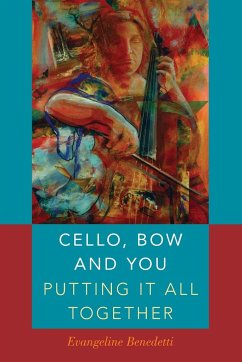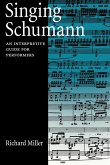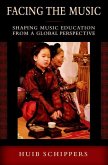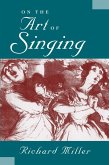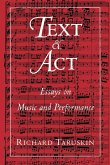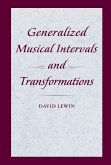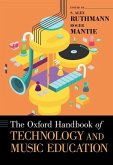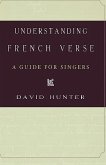- Broschiertes Buch
- Merkliste
- Auf die Merkliste
- Bewerten Bewerten
- Teilen
- Produkt teilen
- Produkterinnerung
- Produkterinnerung
Written for the cellist looking for an approach that demystifies cello playing, Cello, Bow and You is an innovative text in the field of string pedagogy written by a 40+ year veteran of the New York Philharmonic Orchestra and certified teacher of the Alexander Technique. Author Evangeline Benedetti has a unique voice and approach, and invites cellists of all levels to explore, make discoveries and organically internalize technique. Benedetti's approach compliments the work that students do with their teachers by encouraging them to be more aware of themselves and responsive to internal and…mehr
Andere Kunden interessierten sich auch für
![Singing Schumann Singing Schumann]() Richard MillerSinging Schumann50,99 €
Richard MillerSinging Schumann50,99 €![Facing the Music Facing the Music]() Huib SchippersFacing the Music246,99 €
Huib SchippersFacing the Music246,99 €![On the Art of Singing On the Art of Singing]() Richard MillerOn the Art of Singing42,99 €
Richard MillerOn the Art of Singing42,99 €![Text and ACT Text and ACT]() TaruskinText and ACT70,90 €
TaruskinText and ACT70,90 €![Generalized Musical Intervals and Transformations Generalized Musical Intervals and Transformations]() David LewinGeneralized Musical Intervals and Transformations117,99 €
David LewinGeneralized Musical Intervals and Transformations117,99 €![The Oxford Handbook of Technology and Music Education The Oxford Handbook of Technology and Music Education]() The Oxford Handbook of Technology and Music Education232,99 €
The Oxford Handbook of Technology and Music Education232,99 €![Understanding French Verse Understanding French Verse]() David HunterUnderstanding French Verse114,99 €
David HunterUnderstanding French Verse114,99 €-
-
-
Written for the cellist looking for an approach that demystifies cello playing, Cello, Bow and You is an innovative text in the field of string pedagogy written by a 40+ year veteran of the New York Philharmonic Orchestra and certified teacher of the Alexander Technique. Author Evangeline Benedetti has a unique voice and approach, and invites cellists of all levels to explore, make discoveries and organically internalize technique. Benedetti's approach compliments the work that students do with their teachers by encouraging them to be more aware of themselves and responsive to internal and external guidance. Cello, Bow and You allows students and professionals access to Benedetti's vast performance and teaching experience. She has pioneered an approach to playing that is a synthesis of the cellist's musical thought, the knowledge of the dynamic properties of the instrument and bow, and the ability to move effectively according to the mechanics of the human body. The synergy of these elements leads to physically healthy playing and frees players to be musically expressive. Written in engaging, informal prose, the book is a must-read for cellists and cello teachers - beginning, intermediate, or professional.
Hinweis: Dieser Artikel kann nur an eine deutsche Lieferadresse ausgeliefert werden.
Hinweis: Dieser Artikel kann nur an eine deutsche Lieferadresse ausgeliefert werden.
Produktdetails
- Produktdetails
- Verlag: Oxford University Press
- Seitenzahl: 258
- Erscheinungstermin: 1. Oktober 2016
- Englisch
- Abmessung: 234mm x 156mm x 14mm
- Gewicht: 398g
- ISBN-13: 9780190497408
- ISBN-10: 0190497408
- Artikelnr.: 47864606
- Herstellerkennzeichnung
- Libri GmbH
- Europaallee 1
- 36244 Bad Hersfeld
- gpsr@libri.de
- Verlag: Oxford University Press
- Seitenzahl: 258
- Erscheinungstermin: 1. Oktober 2016
- Englisch
- Abmessung: 234mm x 156mm x 14mm
- Gewicht: 398g
- ISBN-13: 9780190497408
- ISBN-10: 0190497408
- Artikelnr.: 47864606
- Herstellerkennzeichnung
- Libri GmbH
- Europaallee 1
- 36244 Bad Hersfeld
- gpsr@libri.de
Evangeline Benedetti has been a member of the New York Philharmonic for more than 40 years. She is also a cello teacher and practitioner of the Alexander Technique.
* Table of Contents
* Prelude
* Forward
* Acknowledgements
* Introduction
* Part I: Sound Image, Cello, Bow and You
* Chapter 1: The Sound Image
* The sound image, or what you hear in your head
* Playing by ear or reading music
* Shaping the sound image
* Becoming your own conductor
* Becoming your own teacher
* Elements of the sound image
* Non- negotiable elements of a musical image
* Negotiable elements decided by the artist
* The cellist's objective
* Part II: Cello, Bow . . .
* Chapter 2: The Cello and The String
* Observation, the approach to the cello and bow
* The beauty of the instrument
* The bridge and the sound post
* The strings
* The nut, tailpiece and fingerboard
* The role of the bow
* Chapter 3: Stringing
* The intersection where the bow meets the string
* Stringing: the quintessence of string playing
* Chain reaction of vibrating the string
* Newton's laws in cello playing
* A sound: beginning, middle and end
* Articulations
* Volume of sound
* The varying amplitude makes the phrase
* Analogy to a triangle
* An exploration of placement
* Amount of hair touching the string
* The shape of the string
* Optimal placement of hair on the string
* Using placement for dynamic changes
* Placement on the four strings
* Chapter 4: The Fingerboard
* The fingerboard grid: an image-based approach
* The blueprint
* Harmonics
* Playing the grid
* Notes in one location
* Changing locations
* In support of intonation
* Learning the fingerboard: positions versus the grid
* Chapter 5: Tools of the Trade: The Left Hand and The Bow
* The left hand
* The left hand tool
* The bow
* Introduction to the bow
* Characteristics of the bow
* The hair
* The screw
* The length of the bow
* Gravity, natural balancing point and center of gravity
* Chapter 6: A Gravity Based Technique for Bowing
* The natural laws and how they affect bowing
* Gravity
* Weight
* Balance: the CG is the NBP
* Gravity-centered approach to the whole bow
* Differences in approach to learning: gravity based compared to
traditional learning
* Changing the vocabulary for bowing instruction
* Legato, the soul of the cello
* The neutral whole bow
* Equalizing the weight of the two ends of the bow
* The shape of the bow guides the movement
* Changing directions respecting Newton
* Imbalance as an ally
* String crossings or changes, using the unbalancing factor
* Chapter 7: Short Notes as Part of the Whole Bow Stroke
* Short Notes: on and off the string
* On the string: détaché, martelé and accented notes
* Off the string: the bouncing bow
* Some things all bounced bows have in common
* Bounced bowing techniques
* The "scoop" spiccato
* The "ball bounce" spiccato
* Bowing techniques with more than one note in each direction
* Up or down-bow staccato/spiccato
* Ricochet or jeté
* Arpeggiated richochet
* Coda
* Part III: . . . and You: Putting it all Together
* Chapter 8: An Overview of You
* Coordination and the Alexander Technique
* Whole body playing
* Opposition as cooperation: co-handedness
* Chapter 9: Sitting and Holding the Cello: Anatomy and Application
* Anatomical vocabulary
* Sitting: the first technique
* The overview of the spine, torso, pelvic basin, legs and feet in
playing
* Details of the pelvis
* The legs and feet as part of cello playing
* The coccyx, sacrum, lumbar spine and thoracic spine
* The anatomy of the head and cervical spine
* The role of the brain and spinal chord in playing
* How to sit: moving from standing to sitting
* The squat-sit process
* How to squat
* How to squat-sit
* Holding the cello: the relationship of the cello and the cellist
* Holding the cello: the perspective from a biomechanical engineer
* The weight of the cello
* The neck and the scroll
* The length of the endpin
* The size of the person
* Bring the cello to meet your body. Do not take your body to the cello
* Chapter 10: Breathing: Anatomy and Application
* Breathing
* The anatomy of the dorsal spine, ribcage, and breathing
* The function of breathing
* The cycle of breath
* The role of breathing when playing
* Breathing naturally
* Breathing for a purpose
* Chapter 11: Hands: Anatomy and Application
* Anatomy of the hands
* Functions of the hands
* Function of the metacarpals
* Function of the thumb
* Rotational function of the forearm and humerus
* Function of the fingertips
* Function applied to cello playing
* The left hand
* The three grips applied to the left hand
* Rotation of the left hand when playing
* Anatomy of the shape of the end of the finger and its role in playing
* Thumb position
* The right hand
* Rotation of the right hand when playing
* Chapter 12: The Arm Moves the Hand: Anatomy and Application
* The shoulder girdle and the shoulder joint
* The anatomy of the shoulder girdle versus the shoulder joint
* The movement of the shoulder girdle
* The movement of the shoulder joint
* The role of the shoulder joints when playing
* The anatomy of the wrist and elbow joints
* The elbow
* The wrist
* The anatomy and function is over
* Chapter 13: Playing the Cello: Anatomy and Application
* Bowing
* The whole bow
* Détaché
* Martelé
* Bounced bow strokes
* Shifting
* Shifting when using thumb position
* Timing of the shifts
* Vibrato
* The finger on the string
* The sound of vibrato
* The speed and width of vibrato
* Energetic force for playing
* Direction of force to the strings with both hands
* Equalizing the energy used by both hands
* Part IV: Practice
* Chapter 14: Practice as Process
* Creative practice as experiment
* Creative practice as research
* Progress is never a straight line and it takes time
* Two paths of learning
* Creating your practice space
* Creating concentration and consciousness
* Setting an agenda
* Assessments
* Pitfalls
* Embrace what is right
* Chapter 15: Rhythm, Melody and Harmony
* Rhythm
* Rhythm as coordinator: the time-space relationship
* Location of the beat within the body
* The intellectual beat
* The sensory beat
* The emotional
* The all inclusive beat
* Illustration of the inclusive beat
* Scales and Harmony in Music
* Scales and melody
* Scales and harmony
* Chapter 16: Auralization and Visualization as Learning Techniques
* Using auralization
* Using visualization
* Learning the skill
* Visualization as looking inward
* Chapter 17: Warming Up
* A practice warm up routine
* Warm-ups before playing
* A rhythmic routine away from the instrument
* Warming up at the Instrument
* Putting it all together
* Chapter 18: Practice Techniques
* Preserving our energy through no-energy practice
* Just the beginning of the note
* Correcting wrong notes
* Changing learned habits
* Reversing
* Postlude: Putting it All Together
* About the Author
* References
* Index
* Prelude
* Forward
* Acknowledgements
* Introduction
* Part I: Sound Image, Cello, Bow and You
* Chapter 1: The Sound Image
* The sound image, or what you hear in your head
* Playing by ear or reading music
* Shaping the sound image
* Becoming your own conductor
* Becoming your own teacher
* Elements of the sound image
* Non- negotiable elements of a musical image
* Negotiable elements decided by the artist
* The cellist's objective
* Part II: Cello, Bow . . .
* Chapter 2: The Cello and The String
* Observation, the approach to the cello and bow
* The beauty of the instrument
* The bridge and the sound post
* The strings
* The nut, tailpiece and fingerboard
* The role of the bow
* Chapter 3: Stringing
* The intersection where the bow meets the string
* Stringing: the quintessence of string playing
* Chain reaction of vibrating the string
* Newton's laws in cello playing
* A sound: beginning, middle and end
* Articulations
* Volume of sound
* The varying amplitude makes the phrase
* Analogy to a triangle
* An exploration of placement
* Amount of hair touching the string
* The shape of the string
* Optimal placement of hair on the string
* Using placement for dynamic changes
* Placement on the four strings
* Chapter 4: The Fingerboard
* The fingerboard grid: an image-based approach
* The blueprint
* Harmonics
* Playing the grid
* Notes in one location
* Changing locations
* In support of intonation
* Learning the fingerboard: positions versus the grid
* Chapter 5: Tools of the Trade: The Left Hand and The Bow
* The left hand
* The left hand tool
* The bow
* Introduction to the bow
* Characteristics of the bow
* The hair
* The screw
* The length of the bow
* Gravity, natural balancing point and center of gravity
* Chapter 6: A Gravity Based Technique for Bowing
* The natural laws and how they affect bowing
* Gravity
* Weight
* Balance: the CG is the NBP
* Gravity-centered approach to the whole bow
* Differences in approach to learning: gravity based compared to
traditional learning
* Changing the vocabulary for bowing instruction
* Legato, the soul of the cello
* The neutral whole bow
* Equalizing the weight of the two ends of the bow
* The shape of the bow guides the movement
* Changing directions respecting Newton
* Imbalance as an ally
* String crossings or changes, using the unbalancing factor
* Chapter 7: Short Notes as Part of the Whole Bow Stroke
* Short Notes: on and off the string
* On the string: détaché, martelé and accented notes
* Off the string: the bouncing bow
* Some things all bounced bows have in common
* Bounced bowing techniques
* The "scoop" spiccato
* The "ball bounce" spiccato
* Bowing techniques with more than one note in each direction
* Up or down-bow staccato/spiccato
* Ricochet or jeté
* Arpeggiated richochet
* Coda
* Part III: . . . and You: Putting it all Together
* Chapter 8: An Overview of You
* Coordination and the Alexander Technique
* Whole body playing
* Opposition as cooperation: co-handedness
* Chapter 9: Sitting and Holding the Cello: Anatomy and Application
* Anatomical vocabulary
* Sitting: the first technique
* The overview of the spine, torso, pelvic basin, legs and feet in
playing
* Details of the pelvis
* The legs and feet as part of cello playing
* The coccyx, sacrum, lumbar spine and thoracic spine
* The anatomy of the head and cervical spine
* The role of the brain and spinal chord in playing
* How to sit: moving from standing to sitting
* The squat-sit process
* How to squat
* How to squat-sit
* Holding the cello: the relationship of the cello and the cellist
* Holding the cello: the perspective from a biomechanical engineer
* The weight of the cello
* The neck and the scroll
* The length of the endpin
* The size of the person
* Bring the cello to meet your body. Do not take your body to the cello
* Chapter 10: Breathing: Anatomy and Application
* Breathing
* The anatomy of the dorsal spine, ribcage, and breathing
* The function of breathing
* The cycle of breath
* The role of breathing when playing
* Breathing naturally
* Breathing for a purpose
* Chapter 11: Hands: Anatomy and Application
* Anatomy of the hands
* Functions of the hands
* Function of the metacarpals
* Function of the thumb
* Rotational function of the forearm and humerus
* Function of the fingertips
* Function applied to cello playing
* The left hand
* The three grips applied to the left hand
* Rotation of the left hand when playing
* Anatomy of the shape of the end of the finger and its role in playing
* Thumb position
* The right hand
* Rotation of the right hand when playing
* Chapter 12: The Arm Moves the Hand: Anatomy and Application
* The shoulder girdle and the shoulder joint
* The anatomy of the shoulder girdle versus the shoulder joint
* The movement of the shoulder girdle
* The movement of the shoulder joint
* The role of the shoulder joints when playing
* The anatomy of the wrist and elbow joints
* The elbow
* The wrist
* The anatomy and function is over
* Chapter 13: Playing the Cello: Anatomy and Application
* Bowing
* The whole bow
* Détaché
* Martelé
* Bounced bow strokes
* Shifting
* Shifting when using thumb position
* Timing of the shifts
* Vibrato
* The finger on the string
* The sound of vibrato
* The speed and width of vibrato
* Energetic force for playing
* Direction of force to the strings with both hands
* Equalizing the energy used by both hands
* Part IV: Practice
* Chapter 14: Practice as Process
* Creative practice as experiment
* Creative practice as research
* Progress is never a straight line and it takes time
* Two paths of learning
* Creating your practice space
* Creating concentration and consciousness
* Setting an agenda
* Assessments
* Pitfalls
* Embrace what is right
* Chapter 15: Rhythm, Melody and Harmony
* Rhythm
* Rhythm as coordinator: the time-space relationship
* Location of the beat within the body
* The intellectual beat
* The sensory beat
* The emotional
* The all inclusive beat
* Illustration of the inclusive beat
* Scales and Harmony in Music
* Scales and melody
* Scales and harmony
* Chapter 16: Auralization and Visualization as Learning Techniques
* Using auralization
* Using visualization
* Learning the skill
* Visualization as looking inward
* Chapter 17: Warming Up
* A practice warm up routine
* Warm-ups before playing
* A rhythmic routine away from the instrument
* Warming up at the Instrument
* Putting it all together
* Chapter 18: Practice Techniques
* Preserving our energy through no-energy practice
* Just the beginning of the note
* Correcting wrong notes
* Changing learned habits
* Reversing
* Postlude: Putting it All Together
* About the Author
* References
* Index
* Table of Contents
* Prelude
* Forward
* Acknowledgements
* Introduction
* Part I: Sound Image, Cello, Bow and You
* Chapter 1: The Sound Image
* The sound image, or what you hear in your head
* Playing by ear or reading music
* Shaping the sound image
* Becoming your own conductor
* Becoming your own teacher
* Elements of the sound image
* Non- negotiable elements of a musical image
* Negotiable elements decided by the artist
* The cellist's objective
* Part II: Cello, Bow . . .
* Chapter 2: The Cello and The String
* Observation, the approach to the cello and bow
* The beauty of the instrument
* The bridge and the sound post
* The strings
* The nut, tailpiece and fingerboard
* The role of the bow
* Chapter 3: Stringing
* The intersection where the bow meets the string
* Stringing: the quintessence of string playing
* Chain reaction of vibrating the string
* Newton's laws in cello playing
* A sound: beginning, middle and end
* Articulations
* Volume of sound
* The varying amplitude makes the phrase
* Analogy to a triangle
* An exploration of placement
* Amount of hair touching the string
* The shape of the string
* Optimal placement of hair on the string
* Using placement for dynamic changes
* Placement on the four strings
* Chapter 4: The Fingerboard
* The fingerboard grid: an image-based approach
* The blueprint
* Harmonics
* Playing the grid
* Notes in one location
* Changing locations
* In support of intonation
* Learning the fingerboard: positions versus the grid
* Chapter 5: Tools of the Trade: The Left Hand and The Bow
* The left hand
* The left hand tool
* The bow
* Introduction to the bow
* Characteristics of the bow
* The hair
* The screw
* The length of the bow
* Gravity, natural balancing point and center of gravity
* Chapter 6: A Gravity Based Technique for Bowing
* The natural laws and how they affect bowing
* Gravity
* Weight
* Balance: the CG is the NBP
* Gravity-centered approach to the whole bow
* Differences in approach to learning: gravity based compared to
traditional learning
* Changing the vocabulary for bowing instruction
* Legato, the soul of the cello
* The neutral whole bow
* Equalizing the weight of the two ends of the bow
* The shape of the bow guides the movement
* Changing directions respecting Newton
* Imbalance as an ally
* String crossings or changes, using the unbalancing factor
* Chapter 7: Short Notes as Part of the Whole Bow Stroke
* Short Notes: on and off the string
* On the string: détaché, martelé and accented notes
* Off the string: the bouncing bow
* Some things all bounced bows have in common
* Bounced bowing techniques
* The "scoop" spiccato
* The "ball bounce" spiccato
* Bowing techniques with more than one note in each direction
* Up or down-bow staccato/spiccato
* Ricochet or jeté
* Arpeggiated richochet
* Coda
* Part III: . . . and You: Putting it all Together
* Chapter 8: An Overview of You
* Coordination and the Alexander Technique
* Whole body playing
* Opposition as cooperation: co-handedness
* Chapter 9: Sitting and Holding the Cello: Anatomy and Application
* Anatomical vocabulary
* Sitting: the first technique
* The overview of the spine, torso, pelvic basin, legs and feet in
playing
* Details of the pelvis
* The legs and feet as part of cello playing
* The coccyx, sacrum, lumbar spine and thoracic spine
* The anatomy of the head and cervical spine
* The role of the brain and spinal chord in playing
* How to sit: moving from standing to sitting
* The squat-sit process
* How to squat
* How to squat-sit
* Holding the cello: the relationship of the cello and the cellist
* Holding the cello: the perspective from a biomechanical engineer
* The weight of the cello
* The neck and the scroll
* The length of the endpin
* The size of the person
* Bring the cello to meet your body. Do not take your body to the cello
* Chapter 10: Breathing: Anatomy and Application
* Breathing
* The anatomy of the dorsal spine, ribcage, and breathing
* The function of breathing
* The cycle of breath
* The role of breathing when playing
* Breathing naturally
* Breathing for a purpose
* Chapter 11: Hands: Anatomy and Application
* Anatomy of the hands
* Functions of the hands
* Function of the metacarpals
* Function of the thumb
* Rotational function of the forearm and humerus
* Function of the fingertips
* Function applied to cello playing
* The left hand
* The three grips applied to the left hand
* Rotation of the left hand when playing
* Anatomy of the shape of the end of the finger and its role in playing
* Thumb position
* The right hand
* Rotation of the right hand when playing
* Chapter 12: The Arm Moves the Hand: Anatomy and Application
* The shoulder girdle and the shoulder joint
* The anatomy of the shoulder girdle versus the shoulder joint
* The movement of the shoulder girdle
* The movement of the shoulder joint
* The role of the shoulder joints when playing
* The anatomy of the wrist and elbow joints
* The elbow
* The wrist
* The anatomy and function is over
* Chapter 13: Playing the Cello: Anatomy and Application
* Bowing
* The whole bow
* Détaché
* Martelé
* Bounced bow strokes
* Shifting
* Shifting when using thumb position
* Timing of the shifts
* Vibrato
* The finger on the string
* The sound of vibrato
* The speed and width of vibrato
* Energetic force for playing
* Direction of force to the strings with both hands
* Equalizing the energy used by both hands
* Part IV: Practice
* Chapter 14: Practice as Process
* Creative practice as experiment
* Creative practice as research
* Progress is never a straight line and it takes time
* Two paths of learning
* Creating your practice space
* Creating concentration and consciousness
* Setting an agenda
* Assessments
* Pitfalls
* Embrace what is right
* Chapter 15: Rhythm, Melody and Harmony
* Rhythm
* Rhythm as coordinator: the time-space relationship
* Location of the beat within the body
* The intellectual beat
* The sensory beat
* The emotional
* The all inclusive beat
* Illustration of the inclusive beat
* Scales and Harmony in Music
* Scales and melody
* Scales and harmony
* Chapter 16: Auralization and Visualization as Learning Techniques
* Using auralization
* Using visualization
* Learning the skill
* Visualization as looking inward
* Chapter 17: Warming Up
* A practice warm up routine
* Warm-ups before playing
* A rhythmic routine away from the instrument
* Warming up at the Instrument
* Putting it all together
* Chapter 18: Practice Techniques
* Preserving our energy through no-energy practice
* Just the beginning of the note
* Correcting wrong notes
* Changing learned habits
* Reversing
* Postlude: Putting it All Together
* About the Author
* References
* Index
* Prelude
* Forward
* Acknowledgements
* Introduction
* Part I: Sound Image, Cello, Bow and You
* Chapter 1: The Sound Image
* The sound image, or what you hear in your head
* Playing by ear or reading music
* Shaping the sound image
* Becoming your own conductor
* Becoming your own teacher
* Elements of the sound image
* Non- negotiable elements of a musical image
* Negotiable elements decided by the artist
* The cellist's objective
* Part II: Cello, Bow . . .
* Chapter 2: The Cello and The String
* Observation, the approach to the cello and bow
* The beauty of the instrument
* The bridge and the sound post
* The strings
* The nut, tailpiece and fingerboard
* The role of the bow
* Chapter 3: Stringing
* The intersection where the bow meets the string
* Stringing: the quintessence of string playing
* Chain reaction of vibrating the string
* Newton's laws in cello playing
* A sound: beginning, middle and end
* Articulations
* Volume of sound
* The varying amplitude makes the phrase
* Analogy to a triangle
* An exploration of placement
* Amount of hair touching the string
* The shape of the string
* Optimal placement of hair on the string
* Using placement for dynamic changes
* Placement on the four strings
* Chapter 4: The Fingerboard
* The fingerboard grid: an image-based approach
* The blueprint
* Harmonics
* Playing the grid
* Notes in one location
* Changing locations
* In support of intonation
* Learning the fingerboard: positions versus the grid
* Chapter 5: Tools of the Trade: The Left Hand and The Bow
* The left hand
* The left hand tool
* The bow
* Introduction to the bow
* Characteristics of the bow
* The hair
* The screw
* The length of the bow
* Gravity, natural balancing point and center of gravity
* Chapter 6: A Gravity Based Technique for Bowing
* The natural laws and how they affect bowing
* Gravity
* Weight
* Balance: the CG is the NBP
* Gravity-centered approach to the whole bow
* Differences in approach to learning: gravity based compared to
traditional learning
* Changing the vocabulary for bowing instruction
* Legato, the soul of the cello
* The neutral whole bow
* Equalizing the weight of the two ends of the bow
* The shape of the bow guides the movement
* Changing directions respecting Newton
* Imbalance as an ally
* String crossings or changes, using the unbalancing factor
* Chapter 7: Short Notes as Part of the Whole Bow Stroke
* Short Notes: on and off the string
* On the string: détaché, martelé and accented notes
* Off the string: the bouncing bow
* Some things all bounced bows have in common
* Bounced bowing techniques
* The "scoop" spiccato
* The "ball bounce" spiccato
* Bowing techniques with more than one note in each direction
* Up or down-bow staccato/spiccato
* Ricochet or jeté
* Arpeggiated richochet
* Coda
* Part III: . . . and You: Putting it all Together
* Chapter 8: An Overview of You
* Coordination and the Alexander Technique
* Whole body playing
* Opposition as cooperation: co-handedness
* Chapter 9: Sitting and Holding the Cello: Anatomy and Application
* Anatomical vocabulary
* Sitting: the first technique
* The overview of the spine, torso, pelvic basin, legs and feet in
playing
* Details of the pelvis
* The legs and feet as part of cello playing
* The coccyx, sacrum, lumbar spine and thoracic spine
* The anatomy of the head and cervical spine
* The role of the brain and spinal chord in playing
* How to sit: moving from standing to sitting
* The squat-sit process
* How to squat
* How to squat-sit
* Holding the cello: the relationship of the cello and the cellist
* Holding the cello: the perspective from a biomechanical engineer
* The weight of the cello
* The neck and the scroll
* The length of the endpin
* The size of the person
* Bring the cello to meet your body. Do not take your body to the cello
* Chapter 10: Breathing: Anatomy and Application
* Breathing
* The anatomy of the dorsal spine, ribcage, and breathing
* The function of breathing
* The cycle of breath
* The role of breathing when playing
* Breathing naturally
* Breathing for a purpose
* Chapter 11: Hands: Anatomy and Application
* Anatomy of the hands
* Functions of the hands
* Function of the metacarpals
* Function of the thumb
* Rotational function of the forearm and humerus
* Function of the fingertips
* Function applied to cello playing
* The left hand
* The three grips applied to the left hand
* Rotation of the left hand when playing
* Anatomy of the shape of the end of the finger and its role in playing
* Thumb position
* The right hand
* Rotation of the right hand when playing
* Chapter 12: The Arm Moves the Hand: Anatomy and Application
* The shoulder girdle and the shoulder joint
* The anatomy of the shoulder girdle versus the shoulder joint
* The movement of the shoulder girdle
* The movement of the shoulder joint
* The role of the shoulder joints when playing
* The anatomy of the wrist and elbow joints
* The elbow
* The wrist
* The anatomy and function is over
* Chapter 13: Playing the Cello: Anatomy and Application
* Bowing
* The whole bow
* Détaché
* Martelé
* Bounced bow strokes
* Shifting
* Shifting when using thumb position
* Timing of the shifts
* Vibrato
* The finger on the string
* The sound of vibrato
* The speed and width of vibrato
* Energetic force for playing
* Direction of force to the strings with both hands
* Equalizing the energy used by both hands
* Part IV: Practice
* Chapter 14: Practice as Process
* Creative practice as experiment
* Creative practice as research
* Progress is never a straight line and it takes time
* Two paths of learning
* Creating your practice space
* Creating concentration and consciousness
* Setting an agenda
* Assessments
* Pitfalls
* Embrace what is right
* Chapter 15: Rhythm, Melody and Harmony
* Rhythm
* Rhythm as coordinator: the time-space relationship
* Location of the beat within the body
* The intellectual beat
* The sensory beat
* The emotional
* The all inclusive beat
* Illustration of the inclusive beat
* Scales and Harmony in Music
* Scales and melody
* Scales and harmony
* Chapter 16: Auralization and Visualization as Learning Techniques
* Using auralization
* Using visualization
* Learning the skill
* Visualization as looking inward
* Chapter 17: Warming Up
* A practice warm up routine
* Warm-ups before playing
* A rhythmic routine away from the instrument
* Warming up at the Instrument
* Putting it all together
* Chapter 18: Practice Techniques
* Preserving our energy through no-energy practice
* Just the beginning of the note
* Correcting wrong notes
* Changing learned habits
* Reversing
* Postlude: Putting it All Together
* About the Author
* References
* Index

